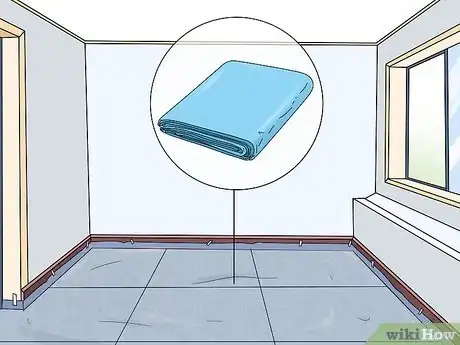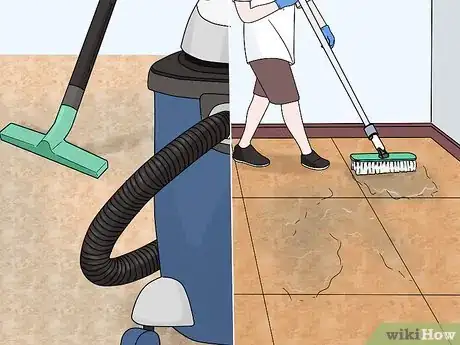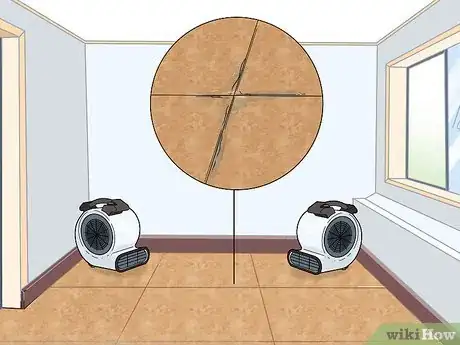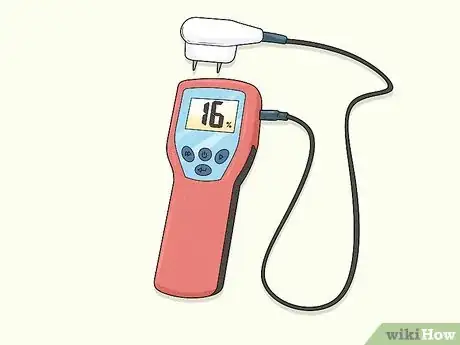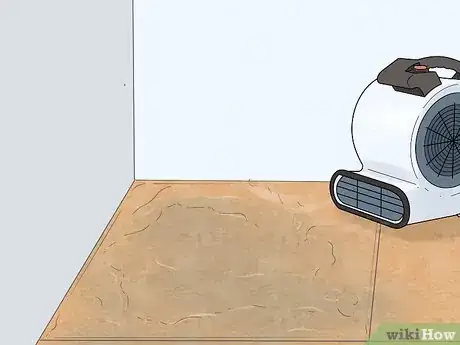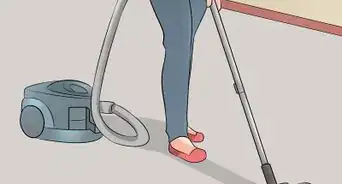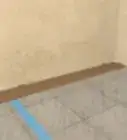This article was co-authored by wikiHow staff writer, Christopher M. Osborne, PhD. Christopher Osborne has been a wikiHow Content Creator since 2015. He is also a historian who holds a PhD from The University of Notre Dame and has taught at universities in and around Pittsburgh, PA. His scholarly publications and presentations focus on his research interests in early American history, but Chris also enjoys the challenges and rewards of writing wikiHow articles on a wide range of subjects.
There are 8 references cited in this article, which can be found at the bottom of the page.
This article has been viewed 21,978 times.
Learn more...
Oriented strand board (OSB) is an economical, sturdy, and long-lasting subfloor material—but only if it remains dry. OSB is slow to soak in moisture, but once it does, it’s vital that you take quick and thorough measures to dry it out.[1] Whether you’re dealing with new construction or an existing home with a finished floor in place over the subfloor, drying out any wet OSB as soon as possible needs to be your goal.
Steps
Drying Subfloors During Construction
-
1Get to work drying the OSB as soon as possible. OSB takes longer to get saturated with water than plywood, but it also takes longer to dry out once it gets saturated. Acting quickly, therefore, means that your job of drying out the subfloor will be that much easier.[2]
- If possible, head to the job site and start drying the OSB subfloor as soon as the rain stops. If the water is caused by another problem, like a leaky water line, get to work drying the subfloor as soon as the water issue is resolved.
- Prevention is the best cure here! Use tarps and other protective measures to keep water away from the OSB in the first place.
-
2Sweep off, suck up, or drain away surface moisture. Use a push broom to sweep away any small puddles that have collected on the subfloor surface. If there are larger or more numerous puddles, use a wet-dry vacuum to suck up the water. Work quickly to remove the water from the OSB before it soaks in.[3]
- If there is a significant amount of standing water on the subfloor, consider drilling several holes through the OSB and letting the water drain away. This works best on a first-floor subfloor above a basement.
Advertisement -
3Use carpet drying fans to encourage airflow. Airflow is essential to drying out OSB. Opening windows and doors (or uncovering window and door openings) helps a little, while using several household box fans is even better. The best option, however, is to use one or several carpet drying fans, which direct a powerful airflow right along the floor surface.[4]
- From the side, a carpet drying fan looks a bit like a really big snail. Fan blades on the sides of the “shell” draw in air, which is directed outward along the floor at the “neck.”
- Purchase or rent carpet drying fans from a home improvement center.
-
4Pay special attention to drying joints, corners, and edges. Moisture that gets trapped between the OSB subfloor and any wall framing can lead to mold and rot. If water has reached these areas, be sure to direct the airflow from one or more carpet drying fans there. Additionally, pay attention to spots where 2 sheets of subfloor meet, since OSB is susceptible to swelling at cut edges.[5]
- In some cases, you may need to remove some of the framing material in order to let the OSB underneath it dry out.
- If the OSB swells at any cut edges, sand it down after the subfloor has completely dried.
-
5Test the OSB with a moisture meter to confirm it’s dry. Don’t just assume the subfloor is dry because it looks or even feels dry. Instead, test it with a moisture meter. Press the meter’s 2 prongs into the OSB—these 2 probes use electrical conductivity to determine the wood’s moisture content. OSB that is sufficiently dry should read at 15%-20%, with 16% as the typical goal.[6]
- Take at least 2 readings for every 100 sq ft (9.3 m2) of wet OSB. The more readings, the better.
- Moisture meters are available at home improvement stores and online.
- Once the tests confirm the OSB is dry, it’s safe to continue construction of the finished floor.
Fixing a Wet Subfloor in Your Home
-
1Repair the water leak or other moisture problem. It may seem obvious, but it’s still worth emphasizing—don’t worry about fixing the floor until you fix the water problem! Otherwise, you’ll never be able to get the subfloor dry. Common culprits include:[7]
- Leaking water pipes.
- Leaking appliances, like a dishwasher or refrigerator.
- A leaky roof, wall, windowsill, door jamb, etc.
- Flooding. If your OSB subfloor has been fully submerged by floodwaters, it will almost certainly have to be completely replaced (along with the finished floor).
-
2Pull up some of the finished floor to test the subfloor’s moisture level. If the floor is carpeted, for example, peel back the carpet in the problem area so you can get a good look at the OSB. If your finished floor is engineered hardwood, pry up a few boards in the problem area to inspect the subfloor.[8]
- Test the exposed subfloor in multiple spots with a 2-pronged moisture meter. If the moisture level of the OSB is above 20%, it needs to be dried out.
- In some cases, it simply won’t be possible to access the OSB subfloor at just a few spots in the area. In this case, move on to removing the entire finished floor in the affected area.
-
3Expose the entire affected subfloor as needed. Keep removing the finished flooring until you find OSB that reads below 20% (and, ideally, at or below 16%) on your moisture meter. If the wet area is near a wall, you may also have to pull away the baseboard in order to expose the OSB underneath. Even though it may end up being a big job, don’t leave wet OSB beneath the finished floor or baseboards![9]
- If the wall is covered in gypsum board (drywall) that comes in contact with the subfloor, you may also have to cut away several inches/centimeters of the wall covering in order to prevent damage from moisture wicking.
- Unfortunately, you may start out thinking that you only need to pull up a small area of flooring, yet end up having to pull up a much larger area. If the job becomes more than you can handle, hire a professional.
-
4Remove any OSB that is structurally compromised. Any areas of OSB that have been soaked through to the point of being structurally unsound must be removed. If the OSB is warped, flaking apart, or “squishy” to the touch, remove it. Either pull up whole sheets with a crowbar of cut away damaged areas with a circular saw.[10]
- If you’re cutting with a circular saw, set the saw depth to equal the thickness of the OSB subfloor—for example, 0.75 in (1.9 cm). Cut out squares or rectangles with edges centered over the floor joists below.
- If the OSB is wet but not structurally unsound, see if you can dry it out before going to the trouble of replacing it.
-
5Dry the damp OSB with commercial fans and dehumidifiers. Set up one or more carpet drying fans, which direct a powerful airflow right across the floor, to increase air circulation over the wet areas. Additionally, plug in a portable home dehumidifier—or, even better, a commercial portable dehumidifier—so that it exhausts dry air over the wet OSB.[11]
- If you have easy access to the underside of the OSB—for example, from the basement below—set up fans and a dehumidifier down there as well.
- To further increase airflow, consider putting a box fan that’s blowing air inward near one open door or window, and another box fan blowing outward at another opening.
-
6Use your moisture meter to make sure the subfloor is dry. Once it’s wet, OSB takes hours to days to dry out. Keep your drying setup going until the OSB looks and feels dry. Then, start testing it with your moisture meter. Stick the 2 probes into the OSB and wait for the reading, and repeat the test at least 2 times per 100 sq ft (9.3 m2) of wet subfloor.[12]
- Aim for 15%-20% moisture, with 16% as the general goal for OSB subfloors.
- If the OSB hasn’t dried out after about 3 days, either the water problem (such as a leaky pipe) hasn’t been solved or the OSB is too saturated to be saved and must be replaced.
-
7Replace any removed OSB, then install the finishing materials. If you pulled up entire sheets of OSB, replace them with new sheets of equal size and thickness. If you cut away pieces of OSB, cut replacement pieces to fit the openings. Secure the subfloor with nails or (preferably) screws driven into the floor joists. Install the finished floor materials on top of the new subfloor.[13]
- All edges of your replacement OSB should rest on (and be secured to) structural lumber. If there aren’t floor joists beneath all of the edges, cut and secure bracing pieces made of dimensional lumber that span between 2 floor joists.
- Like cutting away a rotten subfloor, installing a new one—along with the finished floor on top of it—is a major job for the average DIYer. Hire a professional if you’re not fully confident in your abilities.
Things You’ll Need
- Broom
- Wet-dry vacuum
- Carpet drying fan
- Dehumidifier
- Moisture meter
- Tools to remove and replace damaged OSB (optional)
Warnings
- Do not ignore a wet subfloor! Water-soaked OSB can lose its structural integrity and create an injury hazard. Rampant mold growth is also hazardous to your health.⧼thumbs_response⧽
References
- ↑ https://www.ecohome.net/guides/2190/which-is-better-osb-or-plywood-sheathing/
- ↑ https://www.bobvila.com/articles/526-enhanced-plywood-and-subfloor-products/
- ↑ https://youtu.be/zb6scqkClhg?t=70
- ↑ https://youtu.be/zb6scqkClhg?t=110
- ↑ https://www.bobvila.com/articles/526-enhanced-plywood-and-subfloor-products/
- ↑ https://www.flooring-professionals.com/flooring-resources/wood-subfloor-moisture/
- ↑ https://www.networx.com/article/water-damaged-subfloor
- ↑ https://www.networx.com/article/water-damaged-subfloor
- ↑ https://www.networx.com/article/water-damaged-subfloor
